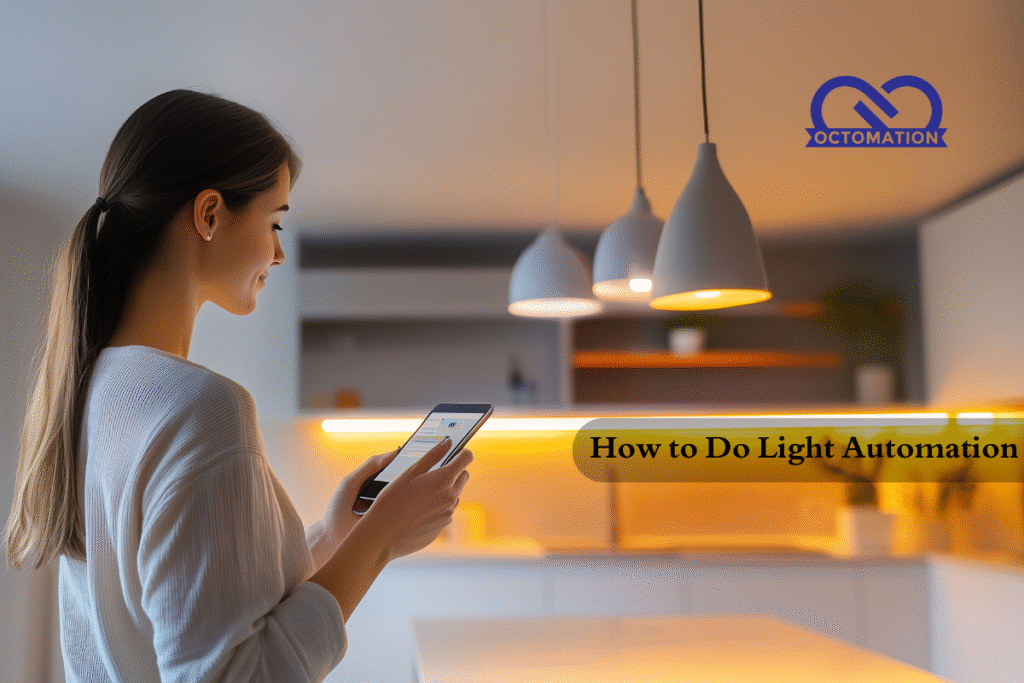How to Do Light Automation

Light automation is now a basic feature of smart home company in Delhi, INDIA technology, improving convenience, security, and energy efficiency. It is no longer a luxury. Whether you’re remodelling your house or creating a state-of-the-art workplace space, we go into great detail in this complete guide on how to plan, deploy, and optimise light automation systems.
Describe Light Automation
Light automation is the process of autonomously controlling lights through the use of smart devices and systems. With the help of applications, calendars, voice commands, or motion sensors, users may dim, turn on, or alter the colour of lights. Control and connectivity are made easy by integration with house assistants such as Apple HomeKit, Google Assistant, and Amazon Alexa.
Automating your lights has the following advantages
Increased convenience.
Voice commands or smartphone apps can be used to operate automated lights from any location. Lights can be programmed to switch on automatically when you get home, thanks to geofencing.
Efficiency in Energy Use
By optimising brightness, employing sensors to detect occupancy, and shutting off lights when not in use, smart lighting systems can help save electricity.
Enhanced Protection
To discourage intruders, lighting can be programmed or activated to mimic occupancy. Safety is increased through integration with security systems.
Ambience and Personalisation
Having dynamic control over colour temperature and brightness improves mood, promotes circadian rhythms, and allows you to customise areas for reading, unwinding, or entertaining.
Light Automation System Types
Independent Smart Bulbs
Your home network is immediately connected to these Wi-Fi-enabled lightbulbs. TP-Link Kasa, LIFX, and Philips Hue are well-known brands. They don’t need a hub and are plug-and-play.

Intelligent Dimmers and Switches
By replacing the current wall switches, smart switches allow standard bulbs to be controlled automatically. They are perfect for multi-bulb configurations and built-in ceiling lights.
Control Systems for Centralised Lighting
High-end systems with specialised control panels and a wide range of programming choices, such as Lutron, Control4, or Crestron, provide sophisticated whole-home automation.
Occupancy and Motion Sensors
Lights are automatically turned off when a room is empty and activated when sensors sense movement. These are perfect for bathrooms, storage spaces, and corridors.
A Comprehensive Guide to Light Automation Implementation
Determine Your Needs
Determine your objectives: Would you like a remote light control? Plan out the lighting situations. Connect to security systems or voice assistants? Identify the indoor and outdoor illumination zones.
Select the Appropriate Technology
Depending on your budget, compatibility, and scalability, choose from smart switches, bulbs, or centralised solutions. Smart bulbs are quick and adaptable for apartments. Centralised or hybrid systems provide greater control for larger households.
Pick a Platform
Verify compatibility with the following platforms:
Alexa from Amazon
Google Home
The Apple HomeKit
SmartThings from Samsung Select one that complements your current ecology.
Set Up Intelligent Equipment
For bulbs, use the app to connect after screwing them in. Turn off the electricity, swap out the switch, and adhere to installation instructions for switches. Professionals should install wired switches and panels.
Use the app to configure the system:
Assign zones or rooms.
Establish routines and schedules.
Make sequences such as “Movie Night” or “Morning Wake-up.”
Modify the colour and dimming settings.
Use Routines to Automate
Utilise app automation to turn on lights in response to:
The time of day
Motion recognition
Sunset or sunrise
Include Voice Control
Connect your lights to a smart display or speaker:
“Hey Google, turn on the living room lights.”
“Alexa, dim the dining lights to 40%.”
For native Apple control, use Siri in conjunction with HomeKit.
Evaluate and Improve
Go over everyday situations. Modify the automation triggers, timings, and brightness. Use voice presets or wall controls to make sure the operation is guest-friendly.
Top Techniques for Light Automation
Make use of zones and scenes.
Control is made easier by classifying lights by function or room. Multiple devices can have their lighting changed with a single command, thanks to scenes.
Combine Different Smart Devices
To strike a balance between control and flexibility, combine smart lighting with sensors and switches. Lights can be further automated by using smart plugs.
Give User-Friendly Interfaces Priority
Voice control and apps might not be to everyone’s taste. To serve all users, install physical smart switches.
Automate With Care
Don’t automate too much. Overly complicated scenarios or an excessive number of triggers can make a scene less usable. Pay attention to ways to improve the quality of life.
Assure Dependable Internet Access
Strong Wi-Fi or Zigbee/Z-Wave mesh networks are necessary for smart devices. Avoid dead zones, particularly in larger residences, by using repeaters or hubs.
Common Errors to Prevent Wi-Fi Network Overload: Use specialised hubs or disperse devices among the 2.4GHz and 5GHz bands.
Ignoring Compatibility: Make sure your gadget is compatible with the ecosystem of your choice at all times.
Ignoring Professional Installation: Smart switch wiring done incorrectly might be dangerous.
Ignoring Security Settings: Use strong passwords and two-factor authentication to protect your devices.
Upcoming Developments in Light Automation
AI-Powered Automation: Lighting that is predicted by AI learning patterns and user behavior.
Energy monitoring: Automatic power-saving recommendations and real-time consumption statistics.
Gesture-based light control is becoming more popular than voice recognition.
Using eco-friendly lighting materials and solar systems together is known as sustainable lighting.
Top Light Automation Tools and Devices
Type of Device Suggested Brands
Intelligent Light Bulbs Wyze, LIFX, and Philips Hue smart switches Leviton Hubs, TP-Link, and Lutron Caseta Philips Hue Bridge Voice Assistants and Samsung SmartThings Motion sensors for the Apple HomePod, Google Nest Hub, and Amazon Echo Conclusion of Aqara, Lutron, and Hue Motion
In addition to improving your living area, light automation offers practical advantages, including security, energy savings, and customised experiences. The secret is careful planning, suitable technology, and intentional automation, regardless of whether you’re starting with a few smart bulbs or creating a fully integrated smart home.